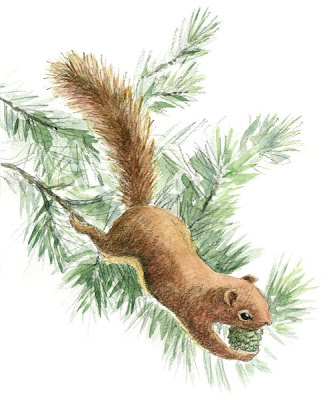
I grew up thinking summers were green and winters white. Where I live now the grasses turned gold two months ago and will return to green in another two months. The valley floor seldom sees snow – just green grass all winter. At least it grows slowly in the cooler season. Even many of the winter trees and bushes are green: green pines and firs, green madrones, green ivy and holly, and green lichens on the browned oaks. The in-between seasons are the prettiest. Daffodils start to bloom in February, followed by a profusion of yellow mustard, white and yellow daisies and magenta sweet peas gone wild.
Now, at the end of summer, deep rooted creamy white Queen Anne’s lace and bright blue chicory continue to thrive. Poison oak has scattered leaves turning crimson and the oaks are slowing drying into browns. At a little higher elevation there will soon be splashes of yellow on the oversized big-leafed maples and sparkles of fire engine red on the vine maples. … but mostly more green, the pines, firs, and spruces.
Driving up river we see a sure sign of fall. The turkey vultures are kettling. First I see about 75 vultures soaring on the north side of the highway, then I realize there are at least that many or more on the south side of the highway. Up, up and soon away. It is like the whole cast of a theater troop coming out for a final bow before the curtain comes down.
We’ve come upriver hoping to find dragonflies. Still in the 50s when we arrive at Diamond Lake. A few damselflies are low to the ground, but no flying dragonflies. Once dragonflies start flying I can usually find where a few have perched, but I never seem to be able to find where they spend the night. They must work their way into the vegetation and out of harm’s way. I’m sure a few still survive.
We arrive at a nearby pond, in time to eat lunch. The pond is small and sheltered from today’s breeze. The sunny edge between water and forest is pleasantly warm. Darners fly along the shoreline. Crimson-ringed whitefaces and a few meadowhawks (all dragonflies) perch on downed logs, in the short grasses and on the ground. I walk the pond edge slowly and find a few damselflies but no sedge sprites. We were hoping the the little sedge sprites would still be flying, but it appears we are too late. We last saw them on Aug 21, just two days ahead of their official ‘last day of their flight season.’ There were so many on the 21st we knew we could get an official later date, but we waited too long. Hot summer days suddenly vanished, and along with many dragonflies and damselflies.
Nearby I hear twigs breaking. First I look to see if is someone or something is breaking their way through the nearby woods. I’ve seen elk tracks nearby and we should always keep half an eye open for black bear; but, no, the sound comes from above. Ah ha! Way high in a lodgepole I see a branch shaking. It is a chickaree harvesting cones for winter. Chickarees are kissing cousins to red squirrels. They look the same except they have a creamy, almost peachy belly, and a little dark line between belly and back. They are just as saucy and just as busy as the red squirrels I grew up with in Wisconsin.
This little chickaree is an efficient harvester. He climbs virtually to the end of a swaying branch and reaches out to nip off one tight, green cone after another. Same fall with just a little ‘thunk’ on the ground, but others crash their way down, breaking little twigs along the way.
Last time we parked here we happened to park between the chickaree’s current caching spot and the cones he had already dropped. He was busy running cones, one at a time, into a thick stand of young lodgepoles. The cones are still green and oozing pitch; and his face all sticky with sap. It’s a small price to pay for a good harvest.



Dear Elva,
ReplyDeleteI love this work!! How cute! Please pass my hello to your little friends.
Cheers, Sadami